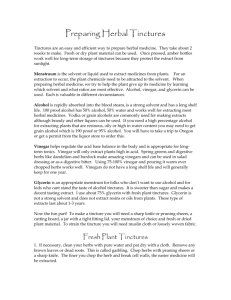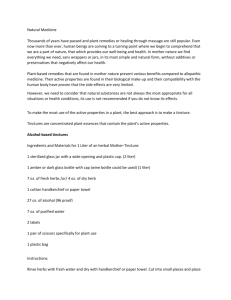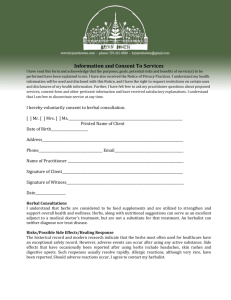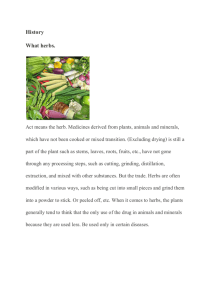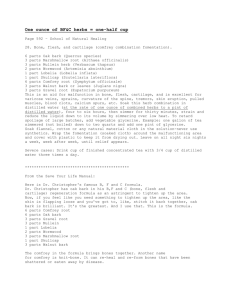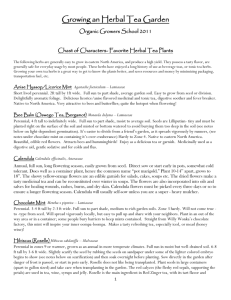How to Make Herbal Preparations 2
advertisement
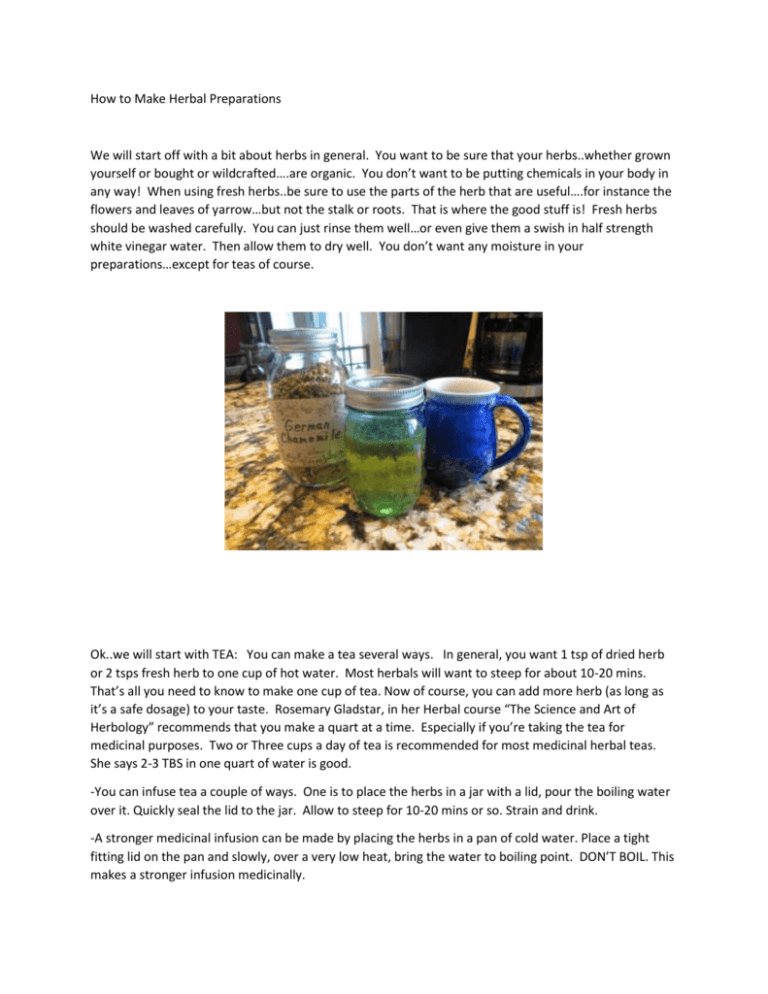
How to Make Herbal Preparations We will start off with a bit about herbs in general. You want to be sure that your herbs..whether grown yourself or bought or wildcrafted….are organic. You don’t want to be putting chemicals in your body in any way! When using fresh herbs..be sure to use the parts of the herb that are useful….for instance the flowers and leaves of yarrow…but not the stalk or roots. That is where the good stuff is! Fresh herbs should be washed carefully. You can just rinse them well…or even give them a swish in half strength white vinegar water. Then allow them to dry well. You don’t want any moisture in your preparations…except for teas of course. Ok..we will start with TEA: You can make a tea several ways. In general, you want 1 tsp of dried herb or 2 tsps fresh herb to one cup of hot water. Most herbals will want to steep for about 10-20 mins. That’s all you need to know to make one cup of tea. Now of course, you can add more herb (as long as it’s a safe dosage) to your taste. Rosemary Gladstar, in her Herbal course “The Science and Art of Herbology” recommends that you make a quart at a time. Especially if you’re taking the tea for medicinal purposes. Two or Three cups a day of tea is recommended for most medicinal herbal teas. She says 2-3 TBS in one quart of water is good. -You can infuse tea a couple of ways. One is to place the herbs in a jar with a lid, pour the boiling water over it. Quickly seal the lid to the jar. Allow to steep for 10-20 mins or so. Strain and drink. -A stronger medicinal infusion can be made by placing the herbs in a pan of cold water. Place a tight fitting lid on the pan and slowly, over a very low heat, bring the water to boiling point. DON’T BOIL. This makes a stronger infusion medicinally. -There are other ways to make teas too. You can skip the hot water part..fill the jar and make a solar infusion by sitting it out in the Sun for a few hours..I’m sure you’ve heard of Sun Tea! There are also Lunar infusions….so magickal for us Witches who use the Energy of the Moon! Keep in mind that many herbs don’t necessarily taste good. Herbs are often bitter and can smell like dirt LOL. Use honey to help sweeten them. You can also add teas to other drinks like juices to help. Also a tea infusion is wonderful to add to your bath or to soak your feet! The next preparation we’ll talk about is TINCTURES: A tincture is a concentrated liquid form of an herb this is easy to make and easy to take. Tinctures preserve and concentrate the medicinal properties of herbs making them more effective. By the way…save your glass jars! They are the best way to make herbal preparations. Ball or Mason jars are great to have around..so are pickle, mushroom, fruit, honey jars..etc etc. Re-use and re-cycle! To make a tincture…get a clean jar (some people sterilize them) with a tight fitting lid. You will need to fill the jar with clean, dry, fresh herb (chopped). Or you can fill it about halfway with dried herb. Pour 80 proof vodka, rum, gin or brandy over the herbs til they are covered well…leave a little breathing room in the top of the jar..and inch or two. Poke the herbs with a stick or end of a spoon to get all the bubbles out etc. Seal the lid. Now place the jar in a warm, dark place. Shake daily for about 3 weeks. I brew my tinctures for about 6 weeks. You can brew from 3 weeks to 6 months. When the tincture is ready…just strain out the herbs using a sieve or cheesecloth. Store it in colored bottles with droppers for ease of use. Keep it in a cool, dark place. Some people refrigerate them but in general, you don’t have to. *You can do a tincture with apple cider vinegar following the same directions except warm the cider first. To administer a tincture…well, do your research. A lot of tinctures will say to take 1/4 tsp in water, tea or juice 2-3 times a day for a chronic illness. For acute illness, you can take 1/8 tsp to 1/4 tsp until the symptoms (such as headache) pass. I know many people do the under- the- tongue administration too. I prefer mixing it with something, so it’s not harsh on my mucous membranes. *You can also use tincture as a rub or liniment. Now on to HERB-INFUSED OILS: This is basically infusing a carrier oil such as Olive, Sunflower, Almond, Jojoba, Grapeseed etc etc….with herbs, to use for multiple reasons. Pick the carrier oil depending on the usage. If it’s for culinary purposes…pick olive, sunflower or grapeseed. It it’s for making lip balms or bath products..almond and Jojoba are wonderful. Use what you like..they are all wonderful. There is a couple of ways (and more) to do this. One way is just like making a tincture, except to use Oil. Just fill your jar full with fresh herbs, and halfway with dried herbs, cover with the oil, stir, seal the lid, label and store in a warm, dark place. Shake daily. Again, several weeks makes for a good strong concentration. Strain when ready and place in bottles or jars appropriate for what you are using it for. For example, a pretty tall dark bottle with a cork will work great for culinary purposes and a small blue or amber bottle will be great for massage oils. Another way to infuse the oil faster (I use this method all the time for my Verbena Lane Botanicals products) is to let it infuse on the stove or in a slow cooker…keeping it warm but not too hot. You can infuse the herbs for an hour this way or more. I usually warm it for at a couple hours..very low. Then turn it off, cover it, and let it stand til completely cool. Strain, jar, label and store the same as above. *Again, you can also make a solar infusion..there is nothing prettier then jars of herbs in oil, slowly infusing in a sunny windowsill in your kitchen. Just be sure that fresh herbs are really dry…water and oil don’t mix! *There really aren’t any measurements for the amount of herb to oil. If using a jar method, just again, fill it well with fresh, chopped herbs and halfway with dried. Leave an inch or two of space at the top when you pour in the oil. For the stovetop method..I generally use a cup or two depending on the herb, then cover to two inches above the herb with oil. Lastly, we will talk about SALVES or BALMS. Now some will say what is the difference between a salve and a balm? Some will say the words are used interchangeably and I can agree with that. For me, I To make a Balm or Salve….you need about a cup of that herb-infused oil you make above. Let’s say we are making a Yarrow salve since I just posted about Yarrow last week here on the Stew. This is a good basic recipe for a healing balm. You’ll need: 1 cup of herb –infused oil 1 oz of good beeswax (slightly less if you want the balm/salve softer and creamier) 1 tsp vitamin e oil (helps to preserve the oil and good for your skin!) 40-60 drops of essential oils if you like. (I use more!) When using the stove to make balm or salve…you want to use a double boiler. A double boiler helps to keep you from burning or over-cooking your oils as you warm them. My method is to bring water to a simmer in a metal or glass pan….then I place a large glass measuring cup right in the water..that works well too. Don’t burn yourself removing the glass cup from the pan! Place the cup of yarrow-infused oil in the pan or glass measuring cup. Start warming it. Grate or chop the beeswax and add it to the warmed oil. Stir occasionally until it melts all the way. Remove from the heat and add the vitamin e oil and essential oils if you wish. For healing, lavender, rosemary, and tea tree essential oils would be a wonderful combination. Pour into containers of your choice. A cup of this oil will make several 2 oz tins, a couple of 4 oz jars or one big 8 oz jar. Let cool. Label and use.

